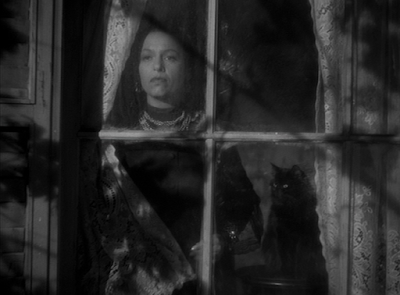Originally staged on Broadway in 1922, first filmed as a silent movie in 1927, then again with sound in 1930 (but since lost)... Super-funny and super-scary, it's 1939's THE CAT AND THE CANARY!
We open on the misty waters of the Louisiana Bayou, as lawyer Crosby (George Zucco) is ferried to his next appointment. "Anyone else living around the old Norman place?" he asks his guide. "Not people," the boatman replies, tracing a portentous circle in the air with his hand. In our first hint of the chills to come, the background music swells into a eerie, drawling squeal...
By the end of the 1930s, the Old Dark House genre had fallen into a predictably silly and largely parodic pattern, but The Cat and the Canary hit the reset button - and hard. Here was a film from Paramount Pictures that stole a sidelong glance at the still-successful horror films of rival studio, Universal, before pouncing over and dragging back a handful of real fear to sprinkle liberally into the Old Dark House formula. Don't let anyone tell you that the humour of The Cat and the Canary outweighs the horror, because this cat has claws!
The structure follows the classic suspense pattern, later exemplified by Hitchcock, who liked to pace his films around three crescendos, or 'bumps' as he called them. Greasing the wheels of the roller coaster is the comedy - of which there's plenty, and it's plenty funny - provided in the form of witty, fast-paced dialogue. Most of the zingers come from leading man Bob Hope, who, as actor Wally Campbell, is familiar with the mystery genre and even comments on the three-act nature of the nightmare unfolding around him.
Wally is one of six relatives gathered for the reading of a will at the aforementioned Old Norman Place, now occupied only by former housekeeper Miss Lu (Gale Sondergaard) and her black cat. Needless to say, not all of the relations are going to come away from the meeting satisfied, meaning that, when the sole heir is revealed (in this case, Paulette Goddard) several others will be left with a motive for murder.

Adding to the atmosphere of peril is the news that a dangerous maniac nicknamed 'The Cat' has escaped from a local asylum and may be prowling the area... In fact, it's a glimpse of this frightening villain that provides the first big 'bump' at the end of the film's first act. This is a masterful scene - one of my favourites in all of Old Dark House horror - in which Paulette Goddard, reading The Psychology of Fear in a darkened room, senses she's not alone. As the audience, we know full well she's not, having seen a secret panel behind her slide silently open and a claw-like hand appear. Most scare scenes involve either sustained low-level tension (the 'anticipation' before a jolt, say) or full-on suspense (a threat hurtling ever closer) but this isn't quite either. On the surface, it's simplicity itself - nothing really happens - yet the way it works, escalating towards a feeling of utter panic as Goddard bolts for the door, makes it one of the best-constructed scares in classic horror.
Bump #2, arriving at the end of the second act, involves the surprise discovery of a body and is again innovative, with the corpse falling towards and yet past the camera. (There's an 'impossible' shot of a body seen 'through' the floor in Robert Zemeckis's What Lies Beneath that always reminds me of this.) And, finally, the story's tortuously extended chase climax provides the ultimate crescendo, pulling no punches whatsoever and featuring a killer with an absolutely massive knife.

Production values are off the chart, with sets and lighting creating an almost three-dimensional space - a distorted funhouse characterized by contradictions: towering ceilings and confined corners; elegance and decay. The longer the characters reside within its walls, the more they too warp into untrustworthy ciphers. In the small number of scenes set beyond the confines of the manor, we discover a tangled, expressionistic jungle that's even more dangerous, and it's here that, naturally, the terrific climax occurs.
The Cat and the Canary is iconic - one of those delicate alignments of fate that results in a sweet perfection. Unusually, the studio was able to repeat the trick the following year, gathering many of the major players and reshuffling them into the more overtly supernatural The Ghost Breakers. I only wish they'd tried for a hat trick, but the fact that the lightning struck twice thankfully left us with a couplet of quintessential scare-comedies.
RATING: 🕸🕸🕸🕸🕸



No comments:
Post a Comment